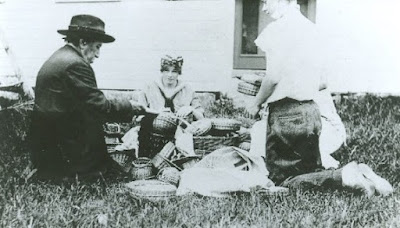People Who Can't Tell "Entomology" from "Etymology" Bug Me in Ways I Can't Put Into Words
x
For example, this is a bug, an Emerald Ash Borer to be specific. The study of insects is called "Entomology." This bug has a starring role in an exhibit that we at the Conway Public Library's Henney History Room helped with and loaned items for.
Entitled Of Baskets and Borers: The Past, Present, and Future of Indigenous Basketry in the White Mountains, the exhibit runs from June 1 – September 14, 2024.
The exhibition explores the past, present, and future of Indigenous basketry in the White Mountains region. As a museum about a place, their exhibitions seek to present stories about the people, plants, and animals of our region. In this case, they will be exploring the intersection between Indigenous basketry, brown ash trees, and the Emerald Ash Borer.
FMI on the exhibit follow this link here.
This blog is about insects, but also about words and language. The study of words is called "Etymology."
Most of the items lent by The Conway Public Library's Henney History Room came from our Laurent family collection.
Joseph Laurent (seen above) and his family sold ash baskets on Conway, but he and his son Stephen were also linguists.
Joseph Laurent was one of three internationally-recognized native scholars responsible for documenting the Western Abenaki language.” His work on grammar, vocabulary, place names, and dialogues was published in 1884, under the title New Familiar Abenakis and English Dialogue.
The Laurents ran an "Indian Shop" and sold a number of souvenirs. The site was established in 1884. In addition to the gift shop building are the remains of five cabins, one wigwam, a flag pole standard, a totem pole standard, and a monument to Joseph Laurent.
In the 1880s, Abenaki Chief Joseph Laurent (1839-1917) began yearly trips to New Hampshire. At first, he spent summers in Center Harbor. During one of his visits, he met William M. Wyman, the proprietor of the Elmwood Inn. They struck up a business partnership. Wyman offered land for a permanent seasonal camp here in the Intervale area of Conway. This piece of land was scenic and conveniently located to nearby hotels and the railroad depot.
In 1884 Joseph Laurent constructed several cabins and began a successful enterprise of selling crafts and providing entertainment to tourists visiting the area. Every summer, Laurent and his family would lead a small band of Abenaki Indians to the camp where they would sell their wares to tourists and locals alike. Laurent operated the camp on a seasonal basis for 33 years until his death in 1917.
The gift shop was originally owned and used by the railroad as a shed for a handcar and tools, it was purchased by Chief Joseph Laurent from a woman who had bought it from the railroad around 1900.
The cabins you see here today were built or moved to the site starting in 1884 and have been remodeled over the years. They were used for a variety of purposes including cooking, storage and sleeping.
You can visit the site today. For directions and information see this link here.
While the entire collection at the library has been inventoried, only 15 items cataloged in past perfect see link here.
We could use some volunteers to helps us document this important collection.













Comments
Post a Comment